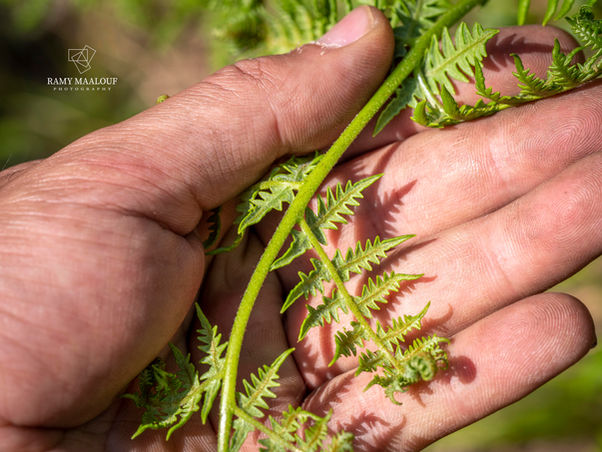Family |
Dennstaedtiaceae
Pteridium aquilinum
(L.) Kuhn
Pteridium aquilinum (L.) Kuhn
(in C.C. von der Decken, Reisen Ost-Afr. 3(3): 11; 1879 – basionym: Pteris aquilina L., Sp. Pl.: 1075; 1753 – Nouvelle Flore du Liban et de la Syrie, vol. 1, Pl. VIII nº 1; 1966)
• Life-form & habit: Robust perennial fern with long, creeping, subterranean rhizomes that give rise to large, solitary fronds. Fronds erect or arching, 50–250 cm tall, forming extensive colonies through vegetative spread.
• Leaves (fronds): Tri- to quadripinnate, triangular in outline, 30–150 × 20–80 cm; pinnae opposite or subopposite, lower ones distinctly stalked and larger; rachis and stipe brownish or purplish, covered with short, crisp hairs. Texture firm, herbaceous when young, coriaceous when mature.
• Sori and sporangia: Sori marginal, continuous along the leaf edge; indusium double — the false indusium formed by the reflexed lamina margin and a true indusium beneath it. Sporangia numerous, globose, yellow-brown; spores trilete, finely reticulate.
• Phenology: Fronds emerge in spring (March–April) and persist until late autumn; sporulation from June to September.
• Habitat & elevation: Prefers humid montane and submontane habitats — forest margins, clearings, moist slopes, and stream banks; thrives on acidic, sandy, or siliceous soils, often in light shade; 600–2 000 m in Lebanon.
• Lebanese distribution: Frequent in the Mount Lebanon range, particularly in Barouk, Ehden, Bcharreh, Ain Zhalta, and Sannine, and extending into the Anti-Lebanon near Rashaya. Mouterde (1966) described it as the most common fern in montane forests, forming large colonies under Pinus brutia, Quercus cerris, and Cedrus libani.
• Native to: Albania, Algeria, Altay, Amur, Antipodean Is., Austria, Azores, Baleares, Baltic States, Belarus, Belgium, Bulgaria, Buryatiya, Canary Is., Central European Russia, Chatham Is., Chita, Corse, Cyprus, Czechia-Slovakia, Denmark, East European Russia, Ethiopia, Finland, France, Germany, Great Britain, Greece, Hungary, Iran, Ireland, Irkutsk, Italy, Kamchatka, Kazakhstan, Kermadec Is., Khabarovsk, Krasnoyarsk, Kriti, Krym, Kuril Is., Lebanon-Syria, Madeira, Magadan, Mongolia, Morocco, Netherlands, New Zealand North, New Zealand South, North Caucasus, North European Russia, Northwest European Russia, Norway, NW. Balkan Pen., Palestine, Poland, Portugal, Romania, Sakhalin, Sardegna, Selvagens, Sicilia, Socotra, South European Russia, Spain, Sweden, Switzerland, Transcaucasus, Tunisia, Tuva, Türkiye, Türkiye-in-Europe, Ukraine, West Siberia, Yemen (POWO).
• Introduced into: Egypt, South Australia (POWO).
• ⚠️ Taxonomic note: Pteridium aquilinum — commonly known as bracken fern — is a cosmopolitan species complex with numerous regional forms. In Lebanon, Mouterde (1966) identified the local taxon as typical P. aquilinum, occurring in humid cedar and oak forests. The species is ecologically significant as an indicator of acidic soils and forest disturbance, and forms persistent colonies through its extensive rhizomes. Though globally widespread, the Levantine populations are confined to montane zones, particularly where soil moisture and shade persist year-round.




